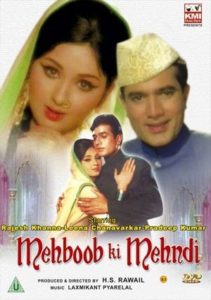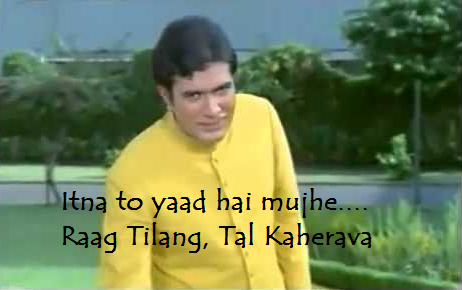Raaga Based Song of the Day: Itna to yaad hai mujhe…
Raag Tilang, Tal Kaherava
We have completed twenty-eight days of Raaga Based Songs of the Day. Our first post in the series was titled ‘Raaga Based Song Of The Day #1’ and the song was a Mohammad Rafi and Lata Mangeshkar song from the 1970 Shakti Samanta movie Pagla Kahin Ka: Tum mujhe youn bhula na paoge. It is in Raag Jhinjhoti, Tal Kaherava.
Our twenty-eighth post was titled ‘Raaga Based Song Of The Day #28’ and the song was a Lata Mangeshkar song from the 1954 Chetan Anand movie Taxi Driver: Jaayen to jaayen kahan. It is in Raag Jaunpuri, Tal Kaherava.
This blog has a number of posts on Raaga based songs in Hindi movies titled similarly; for example: ‘The Best Raaga Based Songs in Hindi Movies – Raaga Pilu – Part I’.
In the last twenty-eight days of sharing Raaga based songs of the day, I have given you songs based on Raag Jhinjhoti, Gara, Bhimpalasi, Madhuvanti, Shivaranjani, Bihag, Pahadi, Sarang, Pilu, Bhairavi, Khammaj, Charukesi, Kalyan or Yaman, Desh, Malgunji, Kirwani, Kedar, Bageshri, Megh Malhar, Bhupali, Ahir Bhairav, Malkaush, Adana, Kafi, Rageshri and Jaunpuri.
Today, I give you a song in Raag Tilang, Tal Kaherava.
However, first, lets take up the value added learning of today. Today, we shall learn about one of the oldest forms of compositions in Indian classical music: Dhrupad. Yesterday, whilst giving you the history of Hindustani Music, I merely mentioned it in the passing:
The name Dhrupad, a Sanskrit name, is a combination of two words: Dhruva means immovable or permanent (Recall Dhruva, the Pole Star through which ancient mariners used to establish North), and Pad means Verse. The oldest reference to Dhrupad is in Natyashastra (200 BC to 200 AD). Some six to eight hundred years later, there is mention in Bhagwat Purana (remember how I extolled our ancient musical heritage in the very first post of the series) which contains not just hymns for Lord Krishna but also musical theories of ancient times.
Dhrupad, therefore, came to denote both poetic style and singing style. Its bhaav is religious and spiritual and it evokes feelings of thoughtfulness, moral wisdom and even heroism. Initially it was sung in praise of Hindu deities. However, yesterday I told you about how Hindu Music found its way courts of Muslim kings and there it was to sing praises of them.
“Dhrupad has at least four stanzas, called Sthayi (or Asthayi), Antara, Sancari and Abhoga. The Sthayi part is a melody that uses the middle octave’s first tetrachord and the lower octave notes. The Antara part uses the middle octave’s second tetrachord and the higher octave notes. The Samcari part is the development phase, which holistically builds using parts of Sthayi and Antara already played, and it uses melodic material built with all the three octave notes. The Abhoga is the concluding section, that brings the listener back to the familiar starting point of Sthayi, albeit with rhythmic variations, with diminished notes like a gentle goodbye, that are ideally mathematical fractions such as dagun (half), tigun (third) or caugun (fourth). Sometimes a fifth stanza called Bhoga is included.”
As I mentioned, today’s song is composed in Raag Tilang, Taal Kaherava. It is only apt that I should bring out Raag Tilang today since yesterday only we took up the history of Hindustani Music and I mentioned in detail about the fusion of first Sanskrit and later Hindi music with Islamic music, particularly Sufi music that was introduced by Amir Khusrow.
Tilang belongs to Khammaj Thaat. It borrows a lot from Sufi tradition. It is used a lot in Thumri and Khayal. In the Raagmala at the end of Sri Guru Granth Sahib it is shown as a Raagini of Hindol.
Having been placed in Khammaj Thaat makes it a raaga of the night (second prahar), having romantic mood with a hint of yearning (O sajana barkha bahaar aayi, for example).
In the Sri Guru Granth Sahib, Tilang has a lot of Islamic vocabulary too. There are a total of twenty hymns in SGGS having been composed in Tilang: Six by Guru Nanak, three by Guru Ram Das, Five by Guru Arjan Dev, Three by Guru Tegh Bahadur, one by Kabir and two by Namdeo.
Some of the songs composed in Raag Tilang are:
| 1. 2. 3. 4. 5. 6. 7. 8. 9. 10. 11. 12. 13. 14. 15. 16. 17. 18. 19. 20. |
Sajan Sang Kahe Main Apne Aap Se Bata Do Koi Bata Do Koi Aaj Mero Man Been Chota Sa Balama Lagi Nahi Chhute Meri Kahani Bhulne Is Duniya Mein Tum Kahe Ko Neha Is Dil Ke Tukde Man Mora Bawara Kismat Bigdi Paijaniya Chhanke Ram Itna To Yaad Hai Mujhe Sawan Ka Mahina Piya Tose Naina Ja Main Tose Naahi Kaise Kahein Hum O Gori Gori Gaon Ki |
Main Nashe Mein Hoon Son Of India Madhu Madhu Gawaiya Ragini Sautela Bhai Deedar Dillagi Jasoos Pyar Ki Jeet Ragini Afsana Wapas Mehboob Ki Mehndi Nehley Pe Dehla Guide Sautela Bhai Sharmilee Yeh Gulistan Hamara |
Lata Rafi Manna Dey Lata Talat Mehmood Asha Lata, Meena Kapoor Rafi Rafi Asha Rafi Rafi Mukesh Rafi Rafi, Lata Lata, Kishore Lata Lata Kishore Kishore, Lata |
 I have taken the song from the 1971 HS Rawail (He is incidentally the director of the movie of my all time favourite song: Mere Mehboob, Sunghursh and Laila Majnu) movie Mehboob Ki Mehndi starring Rajesh Khanna and Leena Chandavarkar. Laxmikant Pyarelal composed some really delightful songs in the movie on the lyrics of Anand Bakshi.
I have taken the song from the 1971 HS Rawail (He is incidentally the director of the movie of my all time favourite song: Mere Mehboob, Sunghursh and Laila Majnu) movie Mehboob Ki Mehndi starring Rajesh Khanna and Leena Chandavarkar. Laxmikant Pyarelal composed some really delightful songs in the movie on the lyrics of Anand Bakshi.
Please enjoy Mohammad Rafi and Lata Mangeshkar (undoubtedly the singers of the best duets in Hindi movies) sing a composition of Laxmikant Pyarelal in Raag Tilang, Tal Kaherava, on the lyrics of Anand Bakshi: Itna to yaad hai mujhe…..
Itanaa to yaad hai mujhe, o, itanaa to yaad hai mujhe, haay,
itanaa to yaad hai mujhe ke unase mulaaqaat huii
baad me.n jaane kyaa huaa, naa jaane kyaa baat huii
Saare vafaa ke karz apane chukaake
kisii se dil lagaake chalaa aayaa
nazare.n milaake, nii.Nd apanii ga.Nvaake
kasak dil me.n basaake chalaa aayaa
din to guzar jaayegaa, kyaa hogaa jab raat huii
itanaa to yaad hai mujhe …
Maare hayaa ke, mai.n to aa.Nkhen jhukaake
zaraa daaman bachaake chalii aayii
pardaa haTaake unakii baato.n me.n aake
unhe.n suurat dikhaake chalii aayii
kis se shiqaayat karuu.N, sharaarat mere saath huii
itanaa to yaad hai mujhe …
Thii ik kahaanii pahale ye zi.ndagaanii
tumhe.n dekhaa to jiinaa mujhe aayaa
dilbar-o-jaanii, sharm se paanii paanii
huii mai.n bas pasiinaa mujhe aayaa
aise mai.n bhiig gayii jaise ke barasaat huii
itanaa to yaad hai mujhe …
We have intended to learn about Raaga based music whilst we entertain ourselves with Raaga based songs. So, lets, once again, take stock of our collective learning so far:
- On the first day we learnt about the Raaga system devised by Pandit Vishnu Narayan Bhatkhande, which is the prevalent system in Hindustani Classical Music and based on ten Thaats.
- On the second day we learnt about Tal or Taal.
- On the third day we learnt about characteristics of Raagas that included Swar, Jati, Thaat, Arohana and Avarohana, Vadi, Samvadi and Pakad.
- On the fourth day, we learnt about Sargam.
- On the fifth day, we learnt about notations used in Indian classical music or simply Swar Lipi.
- On the sixth day, we learnt about the Ras (sentiments) that Raagas evoke.
- On the seventh day, we learnt about various types of Swar: Shuddha, Achal, Vikrut, Komal and Teevra.
- On the eighth day, we learnt the parts of a composition in Indian Classical Music.
- On the ninth day, we learnt the names of some of the popular instruments used in Indian Classical Music.
- On the tenth day, we learnt about the sources of names of Raagas.
- On the eleventh day, we learnt about why Bhairavi is the first raag to be taught to beginners and also why it is the last in a performance.
- On the twelfth day, we learnt about Khammaj Thaat.
- On the thirteenth day, we learnt about Tal Punjabi Theka or Sitarkhani.
- On the fourteenth day, we learnt about Alap.
- On the fifteenth day, we learnt about List of Raagas (Raagmala) in my favourite book: Sri Guru Granth Sahib.
- On the sixteenth day, we learnt about tips for raaga identification.
- On the seventeenth day, we learnt the basics of Gharana system.
- On the eighteenth day, we learnt about Filmi Sangeet.
- On the nineteenth day, we learnt about the commonest Tal in Raagas: Tintal.
- On the twentieth day, we learnt about the Kafi Thaat.
- On the twenty-first day, we learnt a little more in detail about the classification of Raagas.
- On the twenty-second day, we learnt the essential differences between Bhairavi and Bhairav.
- On the twenty-third day, we learnt a little more in detail about the Jati or Jaati of a raaga.
- On the twenty-fourth day, we learnt details of Thaat Bilawal, the most basic thaat in the Bhatkhande’s system of raagas.
- On the twenty-fifth day, we learnt about Tintal.
- On the twenty-sixth day, we learnt in detail about the Raaga – Samay linkage.
- On the twenty-seventh day, we learnt about Lehar.
- On the twenty-eighth day, we learnt about the history of the Hindustani Music.
- And today, on the twenty-ninth day, we learnt about Dhrupad.
There is much more still to be learnt and enjoyed.
Please stay tuned!
